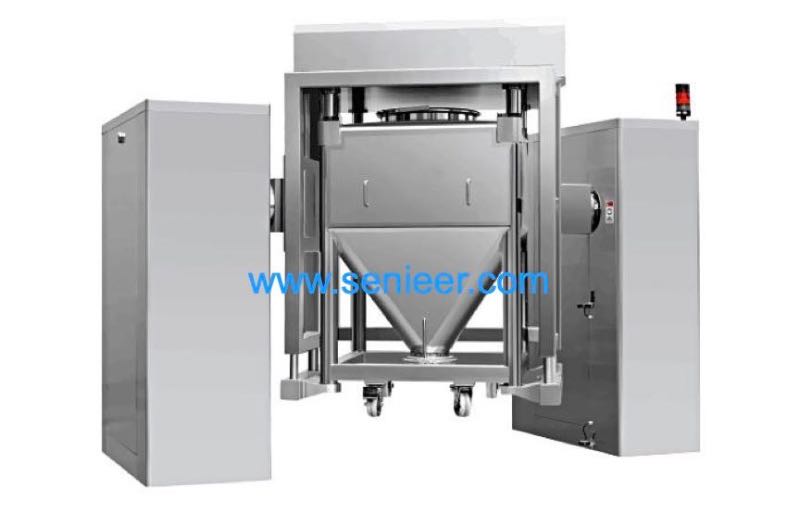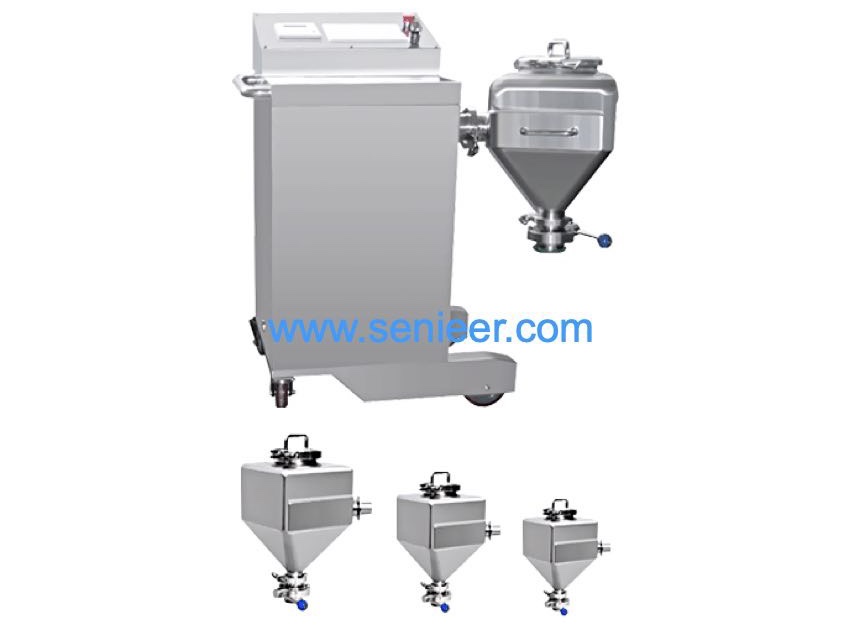Introduction:
A bin blender, also known as container tumbler or industrial blender or v blender, blends dry powders for tablets and capsules production through powder mixing techniques. Many powder mixing techniques are used to produce blender particles that further produce capsules and tablets. A bin blender, that could even be a v blender, facilitates better flow for capsules and tablets through produced blender particles. It is a type of free fall blender that can handle several containers.
Blending Bin or Industrial Blenders are dust-free, closed containers, and have a step transfer system. They come in handy when the blending process requires clamped blending containers in a fixed position or the available container is insufficient for the batch. The bin blender specifications vary according to shapes and sizes. Post Bin Blender, IBC Bin Blender, Fixed Bin Blender, Laboratory Bin Blender, etc. available for your choice depending upon the powder mixing technique.
Suitable industrial blenders or blending bin boasts of high product quality and enhanced quality control while keeping the production cost minimal. They are largely used in the food industry, chemical industry, and other industries. They play a pivotal part in the production of industrial and consumer products such as foodstuffs, pharmaceuticals, etc. The bin blenders are most popular since the machine normally deals with tablets and capsules production.
Industrial Blenders (Bin Blender): Working Principle
The Blending Bin or Blender Bin working principle is quite complex but easy to understand. Tablet and capsule production in bin blenders is a single step transfer system. The draft granules enter IBC containers in the granulation area for blending. The blending process is done through a dust-free connection.
The IBC container is loaded to a blender for the blending process. The IBC bin is locked at 15 degrees in the resting frame. Then it is lifted in a 15° inclined position. Eventually, the IBC container rotates in three dimensions. The container is then loaded over the tablet press for eventual unloading in tablet press hoppers. This is a strain-free convey structure.
Bin Blender Performance and Operation
Operating a bin blender is quite simple. You have to place the bin in the rotary frame, locate the confirmation bottom on the touch screen and press. You will be good to go. The bin is lifted to a suitable height and clamped. The driving system starts running and mixing accordingly, depending on the assigned speed and time.
Hydraulic pumps power the cylinders to clamp the bin into a rotating arm. A blending of the Bin blender sequence is fully automated by using touching screen control. The bin blender performance depends on rotation speed, several rotations, and blend time for every blend recipe for repeatability. Safety interlocks prevent hazards. Infrared lights are used to prevent operation if the operator is near the bin blender.
Pressure sensors trigger the system after receiving signals from the clamp. The braking system jumps into action after the system reaches the assigned parameters hence stopping the rotary frame vertically. This marks the end of the mixing production. The lifting system lays down the bin. At this point you just pull the bin from the rotary frame hence, ending the working cycle. A printer prints the whole production data.
Blending Bin ( Blender Bin ): Key Components
Rotary frame- The rotary flame holds the bin steady, safely, and securely during the blending process. It rotates the bin according to the number of the cycles. Below are the main components of bin blenders.
a. Driving system
The driving system rotates the rotary frame ensuring that blending takes place. It consists of an electric motor attached to the rotary frame using gears, conveyor belts, and shafts.
b. Lifting system
It lifts the bin from the ground using hydraulic pressure.
c. PLC control system
This system controls the blending process when a user key command through HMI. Some of the dates the user can enter include rotation speed, start or stop command, lowering or lifting the bin, and number of cycles.
Bin Blenders in the Pharmaceutical Industry: Why is it Important
Bin blenders or Industrial Blenders are the most used equipment for mixing granular medicine and solid powder in the pharmaceutical industry. Thanks to its high mixing uniformity and mobile hopper it effectively facilitates excellent mixing, discharging, and cleaning. Bin blender can organically be joint in line hence overcoming dust and cross-contamination that results from the separated material transfer. Blending series suffice various, large quantity mixed requirements.
Pharmaceuticals bin blenders or Industrial blenders are convenient to maintain, reliable, and have excellent structure. They meet all the technical requirements for necessary systems, including a pharmaceutical program operating system, safety protection shutdown system, automatic, accurate alignment system, process parameter setting system, and automatic record printing system.
The technical abilities make the automatic production and operation of the blender simple. Also, the bin blender machine is reliable and safe to operate thanks to the proportional position sensor. It is also easy to clean.
Ideal working capacity of Industrial Blender (Blending Bin)
Bin blenders come in a myriad of capacities to meet specific application requirements of different users. At the time customers request custom made bin blenders. However, popular bin blender capacity includes 1000 liters, 5.5 Liters, or smaller than 5.5L. Senieer also custom design bin blenders bigger than 1000L.
Blender Bin: Standard Features
A suitable bin blender should yield a superb uniform mixture of powder or granules. Unlike the older blender versions such as cube blenders, double cones, and V blenders bin blenders are designed so that you can remove the container from the blending after completion of the blending process.
The container is then transported to the next operation process without discharge contents into another vessel. Essentially, this additional feature obviates the need for additional transport containers, thus complicating the granulation line. It also reduces the contact between the operator and the machine hence obviating potential harm. The whole process is controlled using a PLC system rotating according to preset time and speed. Some deal features of a bin blender include:
a. Stain-Free and dustproof
The charging hole has a cover at the top which supports quick opening and closing. The joints are dustproof for particle-free transmission. Ideal bin blenders are dust-free.
b. Flexibility
The bin blender machine should be flexible in the sense that you should be able to switch on container size such that it can dispense varying sizes of production batches in a single piece of equipment. The ability of the bunkers to handle more than one size of containers is an added advantage.
When employed in the manufacturing process, the industrial Blender (Pharma Bin blenders) has several benefits, which include:
- Easy to clean
- Efficient blending
- Simple controls
- Blending recipes automation
- Customization
- High mixing efficiency
- Convenience
- Steady performance
- Compact structure
- Processing data print out
Modern bin blenders can be configured to use any voltage. Additionally, they allow customization to meet your bin blender specifications. Most importantly, suitable bin blenders are of high quality and durable.
Conclusion
When choosing we recommend that you choose a bin blender that is adaptable to various material processing environments. The bin blender performance should be top-notch in the sense that it should handle more than one size of the bulk container. At Senieer we offer quality bin blender that comes in varying designs, sizes, and shapes all at affordable prices.
After purchasing our equipment we provide Sineer supplies installation, training, commissioning, and an operation guide. We will also answer all your questions about bin blenders. Please do not hesitate to contact us if you need custom design bin blenders.












